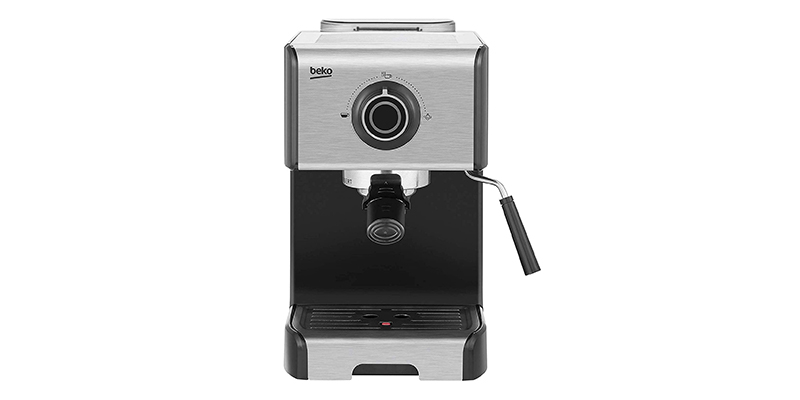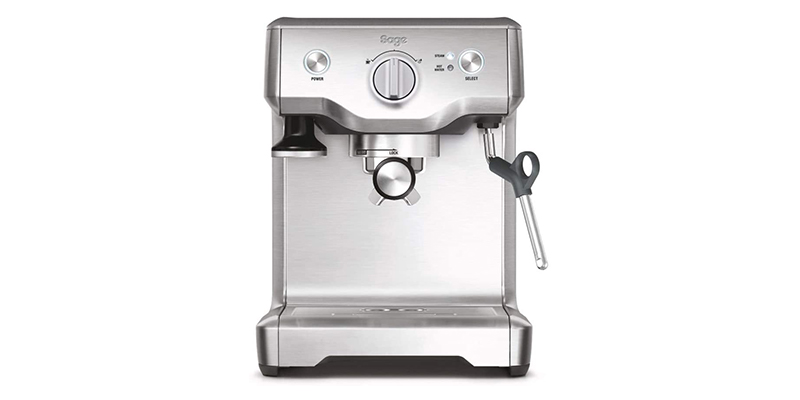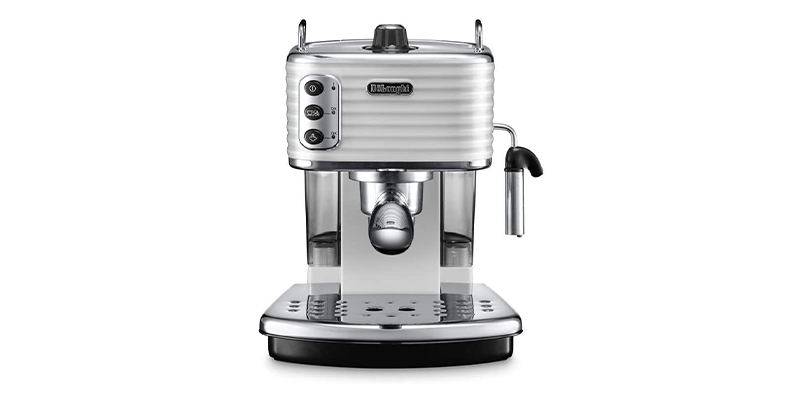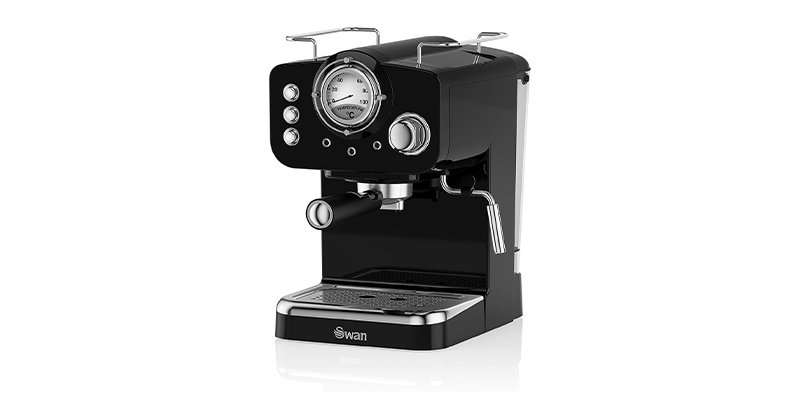The perfect espresso, or any kind of coffee-based drink for that matter, is an integral part of many of the world’s morning routines.
Whether that’s in a coffee shop, office, or simply from home, the perfect espresso can be easily achieved with an espresso coffee machine.
Professional espresso machines are becoming increasingly popular in many homes due to their easy functions, beautiful designs and, of course, the amount of money they can save you.
Although some expensive options can be quite the investment, when compared with buying a coffee from a cafe every day, it’s undeniably more financially sustainable.
We have covered 8 incredible espresso machines plus an in-depth buying guide to ensure you find the perfect fit.
See Our Best Espresso Machines
| # | PREVIEW | Product | |
|---|---|---|---|
| 1
Best For Higher Budgets
1 Sage The Barista Express Espresso Machine
|
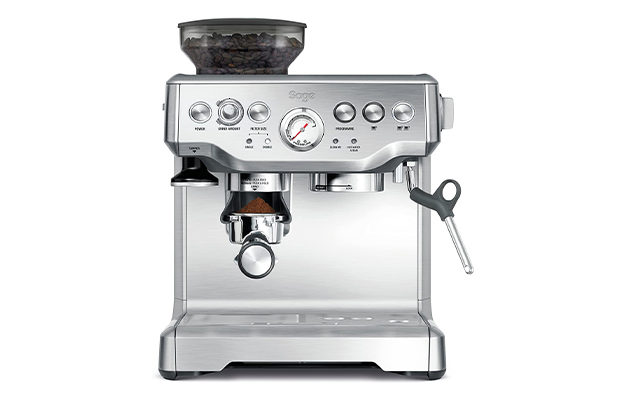
|
 Buy On AO Buy On AO Show other buying options |
|
| 2
Best For Low Budgets
2 Beko CEP5152B Espresso Machine
|

|
 Buy On AO Buy On AO Show other buying options |
|
| 3 |
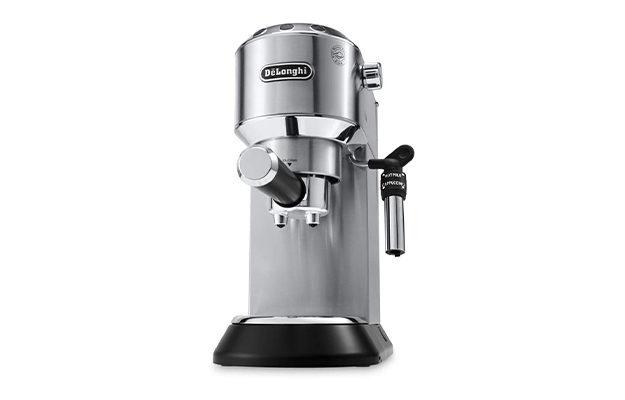
|
 Buy On AO Buy On AO Show other buying options |
|
| 4 |
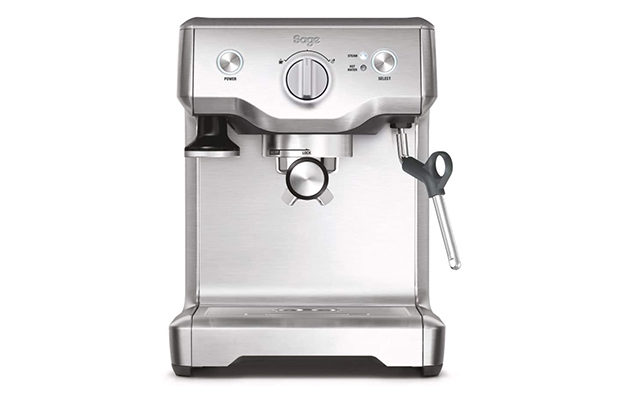
|
 Buy On AO Buy On AO Show other buying options |
|
| 5 |
|
 Buy On AO Buy On AO Show other buying options |
|
| 6
Best Overall
6 De'Longhi Scultura Espresso Machine
|
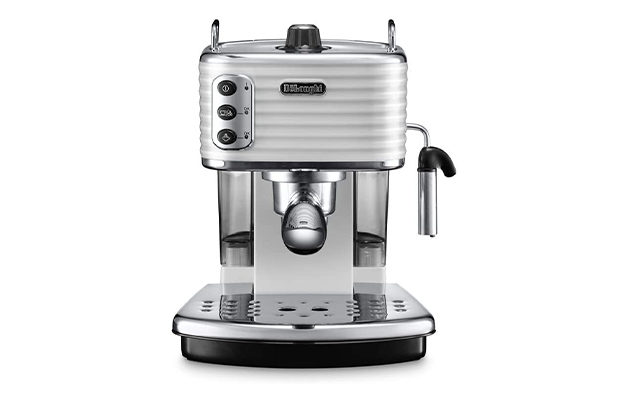
|
 Buy On AO Buy On AO Show other buying options |
|
| 7 |

|
 Buy On AO Buy On AO Show other buying options |
|
| 8 |
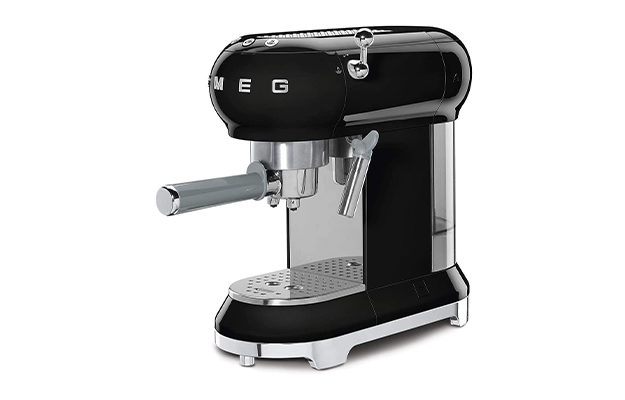
|
 Buy On AO Buy On AO Show other buying options |
|
1. Sage The Barista Express Espresso Machine
- Integrated grinder.
- Low-pressure pre-infusion method.
- High pressure steaming.
- Includes a separate hot water option.
With a sleek stainless steel finish, this espresso machine from Sage is an attractive and professional piece for your kitchen coffee setup.
It includes top-quality necessities for professional use, yet it is extremely easy to use making it a friendly option for home coffee enthusiasts too.
This model includes several features to incorporate your entire coffee routine from start to finish.
Firstly, it includes an integrated coffee bean grinder on top of the machine, which includes 18 different grind options providing you with total customisation.
Next, it has the low-pressure infusion method for the actual making of your espresso, a method that involves soaking the beans first. This provides a well-rounded brew without overburning.
Once the espresso is complete, the high-pressure steaming spout can be used with all kinds of milk.
Additionally, this model includes a separate hot water option to use when heating cups in advance of coffee pouring.
The stainless steel milk jug is included with the unit too!
Specifications
Pros
- Suitable for preheating cups.
- Sleek stainless steel finish.
- Includes a milk jug.
- 2-year repairs or replacements guarantee.
Cons
- Lighting in the tray area would be nice.
- The large size may be unsuitable for smaller kitchens.
2. Beko CEP5152B Espresso Machine
- Integrated light indicator.
- 15 Bar pump pressure.
- Includes a cup warmer.
- High-pressure steam nozzle for milk.
A key design aspect of this Beko model is how unbelievably easy it is to use.
The simple frontal panel includes one rotary dial that has 3 main options for coffee, hot water, and then to activate the milk steamer.
With a 15-bar pump pressure, the actual process of coffee production is fast, the machine pours quickly compared to other models.
Although it doesn’t include as many frills as some other models, it produces the most important aspect perfectly – the espresso.
The upper level of the machine includes a cup warmer plate. This is also a convenient area for storing your espresso cups after using them.
This model functions with pre-ground coffee so it will require the purchase of an additional coffee grinder if you’re passionate about fresh beans.
Otherwise, it is also suitable for ESE coffee pods for ease of use.
Lastly, this model includes an integrated milk frother for creamy lattes and cappuccinos.
The water tank is also removable and easy to clean.
Specifications
Pros
- Suitable for pods and ground coffee.
- Easy to use.
- Control options for the coffee express process.
- Removable water tank.
Cons
- The wattage is lower than some other models.
- An integrated grinder would be nice.
3. De'Longhi Dedica Traditional Pump Espresso Machine
- Includes temperature options.
- Adjustable cappuccino system.
- Slim design fits most kitchen counters.
- Includes a manual descaling system.
De’Longhi has really hit the nail on the head when it comes to the need for an affordable, high quality and attractive espresso machine all in one.
Firstly, this model includes several temperature options, allowing you to adjust the water temperature for your perfect coffee.
This is also excellent for cappuccinos and espresso alike which are best at varying temperatures. The 15-bar pressure provides a rich, aromatic espresso.
The adjustable cappuccino system works with the high-pressure steamer pipe. This can be alternated between frothing or steaming milk for anything from lattes to flat whites.
The only downside we noticed is that the pipe tends to drip a little after it’s used.
In terms of its design, this stainless steel model is robust yet slim.
The widest part of the machine is only 15 centimetres, making it ideal for small spaces.
Lastly, the model includes a manual descaling system, plus an easily-removable water tank. It’s simple to keep clean and fresh.
Bear in mind that it does not have an integrated coffee bean grinder.
Specifications
Pros
- 15-bar pressure.
- Attractive glossy finish.
- Thermoblock water heating system.
- Adjustable drip tray.
Cons
- No integrated bean grinder.
- The milk frother drips a little.
4. Sage The Duo Temp Pro Espresso Machine
- Low-pressure pre-infusion system.
- Microfoam technique when steaming.
- Includes maintenance indicators.
- Automatic purge system.
Sage’s high-quality designs are not cut short with this slightly more compact and simplified model, plus it includes a friendly price tag.
The espresso machine includes precise extraction thanks to the low-pressure pre-infusion.
The purpose of this is to reveal deeper flavours in the coffee beans during extraction.
On the right-hand side of the machine, there is an integrated high pressure steaming nozzle.
This perfectly steams and froths any kind of milk for delicious cappuccinos or lattes and everything in between.
Plus, the powerful 1600 watt rating allows it to create micro-foam texture.
A helpful feature of this Sage model is the included maintenance indicators. These alert you when the machine requires emptying and cleaning.
The automatic purge system keeps things in order by purging the heating system after every extraction.
Lastly, this unit also has a particularly fast heat-up time thanks to an internal Thermo coil heating system.
Specifications
Pros
- Fast heat up.
- 1.8-litre capacity.
- Easy-to-use control panel.
- Suitable for small and tall cups.
Cons
- No integrated grinder.
- It’s quite wide and unsuitable for smaller surfaces.
5. De'Longhi Icona Vintage Espresso Machine
- Cappuccino system included.
- Dual function filter holder.
- A duo of thermostats.
- No waiting around for the machine to heat up.
This top-notch espresso machine from De’Longhi sets itself apart from others with its vintage-theme design.
The pale beige model is embellished with a stainless steel steamer wand and a water tap, as well as a brown-coloured espresso handle.
Furthermore, this model includes a dual-function filter holder.
This makes it suitable for pre-ground coffee or ESE pods that can be reused too! The dual function makes it a simple-to-use option for beginners.
The customisation options with this model are useful thanks to the two thermostats.
These allow you to control both the water and the steam temperatures, providing the perfect coffee to your exact taste.
Additionally, this machine has a self-priming system, removing any waiting times as it is always ready to be used.
Lastly, a brilliant feature of this model is that it is anti-drip. Plus, the water tank is removable for easy cleaning.
Specifications
Pros
- Anto-drip.
- Removable water tank.
- Includes a water level indicator.
- Cup warmer.
Cons
- Some may not like the vintage design.
- It doesn’t include a milk jug.
6. De'Longhi Scultura Espresso Machine
- Includes a cappuccino system.
- Stylish modern design.
- Perfect espresso production.
- Lightweight for its size.
This is a super stylish espresso machine with the ideal features for both professional and home use.
Plus, it’s stainless steel and white design looks beautiful in any kitchen decor.
The glossy finish gives it an expensive-looking appearance, while the price point is friendly.
Firstly, this model includes a cappuccino system for frothy coffee lovers. It’s also suitable for latte and flat white making. It functions manually and is ideal for both dairy and plant milk.
As well as the great milk frothing features, the espresso production of this machine is exceptional.
It holds a 15 bar pressure system that crafts rich espresso with deep aromas and hazel-coloured cream on top.
This model works with pre-ground coffee and ESE pods. Plus, it’s easy to operate with just 3 frontal push-buttons.
Furthermore, this De’Longhi model weighs around 4 kilograms, making it a lightweight option particularly compared to its robust size. The drip tray is removable and dishwasher-safe for easy cleaning.
Specifications
Pros
- Easy to operate.
- Suitable for ESE pods too.
- Removable drip tray.
- Glossy finish.
Cons
- The steamer drips a little.
- Not so suitable for small spaces.
7. Swan Retro Espresso Machine
- 2 cups at once.
- Includes a steam pressure control.
- Large 1.2-litre water tank.
- Traditional milk frother attachment.
This Swan espresso machine differs from many other traditional models with its awesome retro design.
The black frontal panel features an oversized temperature gauge which is both attractive and useful – indicating when the machine reaches the suitable temperature for extraction.
Furthermore, the base of this machine features enough space to create two cups at once, plus the dual-spout portafilter.
The base of the machine is also very spacious, allowing you to use tall and short glasses.
The large 1.2-litre water tank removes the need for constant refilling when using the machine several times over in one go.
The right-hand side of this machine includes a rotatable high pressure steaming wand.
This allows you to froth, steam and heat milk for cappuccinos, lattes and other coffee drinks.
As it twists to the side, it’s an easy option for taller glasses too.
A downside of this model is that the plastic finish doesn’t feel as luxurious or long-lasting as stainless steel alternatives.
Specifications
Pros
- Unique retro design.
- Suitable for small professional environments.
- 2-year warranty.
- Spacious base.
Cons
- It doesn’t feel as robust as some other designs.
- The tall size doesn’t fit under integrated wall cabinets.
8. Smeg 50's Retro Espresso Machine
- Thermoblock heating system.
- Descaling light.
- Includes a water level indicator
- 3 different functions.
This glossy, traditional Smeg-design espresso machine is functional and compact.
It’s high price point is paired with top-notch internal and external technology.
Firstly, this model includes a flow-stop function.
This allows you to adjust the size of your coffee based on how much is released from the machine, making it perfect for both expressos and longer coffees alike.
We loved that this model is very fast to heat up thanks to the internal thermoblock heating system. This rapid boiling system produces your coffee within minutes.
Plus, the 15-bar pressure system makes this machine suitable for professional use.
Furthermore, this model includes a water level indicator and a descaling light to keep maintenance quick and easy.
The downside of this model is that, despite the high price-point, it does not include its own coffee bean grinder.
Lastly, it’s super easy to use with 3 simple push-buttons on the top of the machine to move between the 3 functions.
These are for one cup, two cups and steaming.
Specifications
Pros
- 2-year warranty.
- Pro 15-bar pressure.
- Adjustable cappuccino system.
- Flow-stop function.
Cons
- It’s expensive.
- An included grinder would be nice.
Espresso Machine Buying Guide
Brands
Different brands of any appliance tend to have certain flagship qualities.
For example, Smeg has its traditional retro design while Sage is generally known for its stainless steel finishes.
Breville, an Australian brand of small appliances, are found worldwide. They are particularly well-known for their coffee machines, blenders and kettles.
The brand Breville actually operates in the U.K under the brand-name of Sage, so you can regard them as sister brands.
DeLonghi is an Italian based and founded brand of appliances, established in 1902.
A well-praised aspect of the DeLonghi brand is the variety of appliances as well as the variety within each appliance category.
This includes both technological aspects, sizing, pricing and features – as you will have seen above with the various DeLonghi espresso machines.
Type
The type of espresso machine, whether it’s automatic or semi-automatic, is an important factor to consider when making your purchase.
This is particularly important to consider based on your knowledge and skill level when it comes to espresso making.
Fully Automatic
A fully automatic espresso machine gives a lot away in its name.
In short, it takes all the hard work away and completes the entire brewing process by itself, determining the volume of water that will be extracted through the coffee grounds.
Semi Automatic
Semi-automatic machines differ slightly in that you are still required to do a little work before the machine will take over.
This involves grinding and tamping the coffee yourself before the machine controls the brewing process.
Steam Wand
Steam wands are essential on most, if not all, espresso machines.
They tend to be attached to the left or right-hand side of the machine to the side of the portafilter.
After filling a stainless steel milk jug, the steam wand can be placed into the milk. These work to heat the milk with steam, while gentle texturising it.
The downside is that milk doesn’t get as creamy or frothy with a steam wand as it will with a dedicated milk frother.
Milk Frother
If you are a cappuccino lover, a milk frother will be your new best friend.
These machines tend to be separate from espresso machines either as handheld whisk-like devices or larger machines.
The internal whisks work by incorporating air into the milk, resulting in a very light, fluffy microfoam – the perfect cappuccino.
Although these are not essential and a steam wand will work just fine, if you’re particularly fond of frothy milk in your coffee then this makes a justified investment!
Water Tank
The water reservoir of an espresso machine is the integrated container that should be filled up with fresh drinking water to be used in the produced coffee.
Two important factors to consider when looking at the machine’s water tank are the size and whether or not it is removable.
The size of the tank is important, particularly if you are using the machine for professional use as you need to ensure the tank is large enough to not need regular refilling.
On the other hand, home-use espresso machines can get away with smaller tanks under 1 litre as they won’t be serving so many people at one time.
An easily removable tank is important to keep scale and condensation buildup to a minimum.
Size
One of the key deciding factors in purchasing your new espresso machine will likely be the size.
Firstly, the size you can get is determined by how much space you have available for the coffee machine.
If you’re looking for a model suitable for home-use then a mini espresso machine may be ideal. They may be small but they are just as mighty as larger alternatives.
Opt for a narrower version, like the De’Longhi Dedica Style if you don’t have much counter space available.
Larger models are best suited for spacious kitchens or professional environments like cafes and restaurants. A larger model that includes its own grinder would be the Sage Barista Express model.
Material
While most espresso machines function in similar ways, the materials they are crafted from can affect the quality, longevity and appearance of the machine.
Stainless-steel machines are particularly popular due to their durability, appearance and how easy they are to keep clean.
Most espresso machines include many stainless steel parts such as the portafilter and grinder blades (if it includes one).
Alternatively, other models opt for a plastic finish, such as the Smeg Retro espresso machine.
The black glossy plastic gives many machines a modern look while keeping costs lower than metal alternatives.
Pricing Range
The price range with coffee machines is vast, due to their different target markets.
Larger models with integrated grinders and adjustable temperature settings are suitable for professional use and therefore manufacturers can rank up their prices.
The Sage Barista Express fits into this category.
On the other hand, cheap espresso machines tend to be smaller and simpler in design.
Our best budget espresso machine is the Beko CEP5152B Espresso Machine coming in at just over 80 pounds.
The design is simple with just 3 essential functions which keep the price low.
Frequently Asked Questions

After reading the machine’s manual, you can follow these easy steps to use an espresso machine:
- Switch on your machine to preheat it. Depending on the machine this can take anywhere from 5 minutes to 30 minutes.
- Grind your beans and measure them into the portafilter using a scale. Start with around 20 grams for one cup. Alternatively, use pre-ground beans and measure them into the portafilter.
- Tamp your beans, by pushing them straight down into the portafilter with the tamp to create a levelled surface.
- Attach the portafilter to the main body of the machine – this usually requires twisting it into place. Then, activate the extraction button on your machine to pull the first shot.
- From the first shot, you can determine whether you prefer your coffee stronger or weaker and adjust the weight of beans you use.
Our Verdict
Your coffee taste buds are most likely tingling now after the in-depth reviews and buying guide to find your perfect espresso machine.
We’ve covered 8 different models each with varying features – from professional use large machines to simpler, budget-friendly espresso machines for home use.
The design features between different models alter depending on the brand, price and even materials.
These can include more features, different finishes and different sizes.
If you’re still struggling to make your choice, opt for our “Best Overall” rated espresso machine, the De’Longhi Scultura.
Its beautiful stainless steel finish is paired with a friendly price and perfect coffee extraction.


